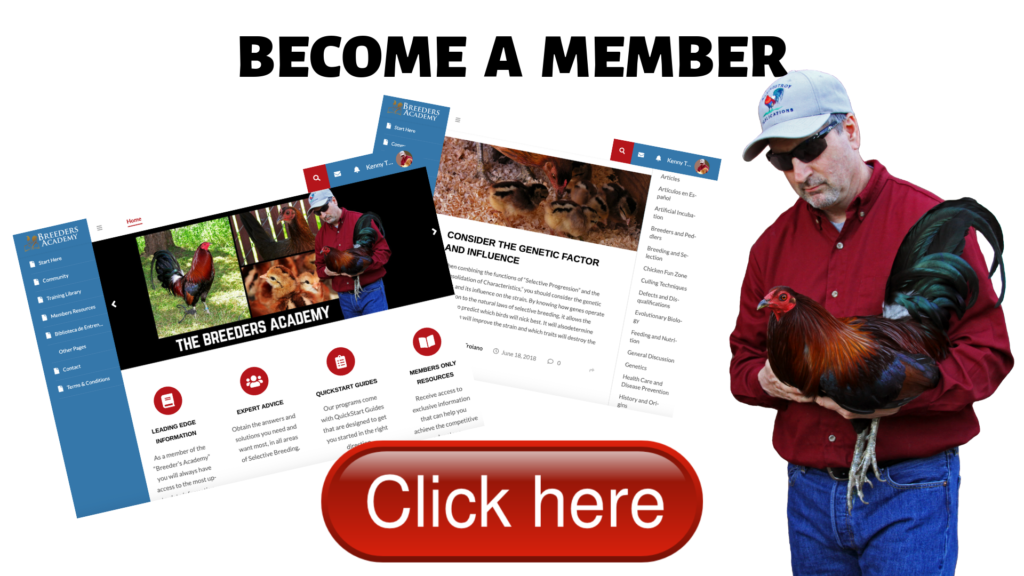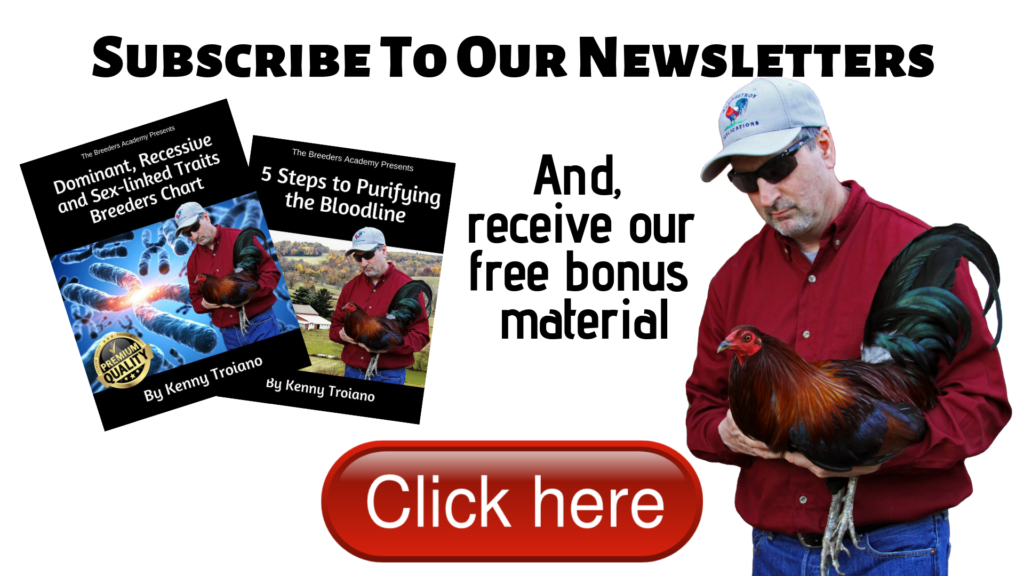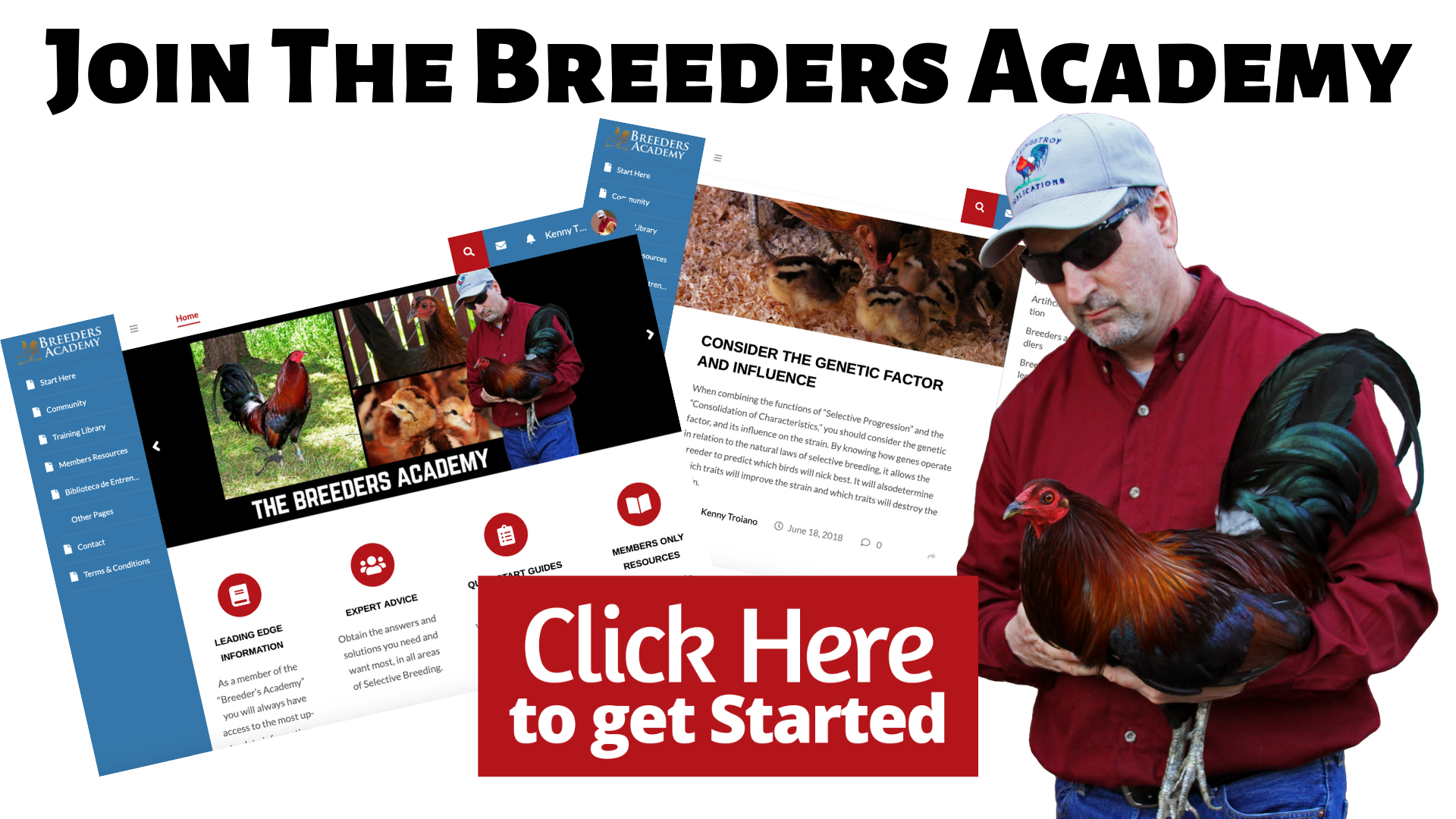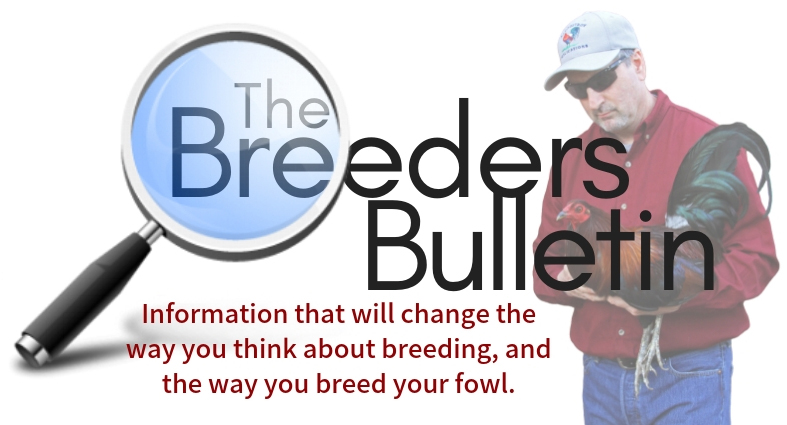From Chicks to Mature Fowl, and Everything In-between
By Kenny Troiano
www.breedersacademy.com
Today, we will discuss the difficult duty of culling. I’ll show you certain defects that you should look for that would surely make them culls.
Culling chicks: The creating, maintaining and improving of a family is only possible through proper culling, and it starts when they first hatch from the egg. Only the strong, eager, active and healthy-looking chicks should be kept. The chicks should also be culled at all stages of their growth and development.
The points of deformities and weaknesses to consider are such things as:
- Crooked toes
- Crooked or crossed beaks
- Blindness
- Inability to stand or walk
- Extruded yolks
- General weakness
- Apparent runts
- Extra appendages, such as too many toes, or a third leg or wing. Don’t laugh, it happens
- Lack of the instinct to eat or drink, etc.
As they mature, check for:
- Crooked breast bones
- Duck-toes or crooked prop toes
- Poor station of legs
- Bow leggedness
- Knocked knees
- Split wings
- Wry tails
- Squirrel tails
- Irregular pupils of the eyes
- And so-on.
Make no exceptions. If you do, it will cost you in the long run. Most of the time I’ll start culling when the chicks are a few weeks old, it is at this time that I do all my toe punching. Chicks which show a lack of vigor, fall behind in growth or have birth defects can be culled before its time to wing band them as well. If you make sure to do this you will have a very select bunch of youngsters by the time they are five or six months old.
You should also cull chicks that do not possess the traits you’re looking for, traits that would not benefit you for improving the strain. For example: If straight (single) combs were to appear in a pea combed family. Since straight (single) combed birds will never be of value in your breeding program, they should be eliminated as soon as possible, or green legs in a yellow legged family, this would be the age to do it.
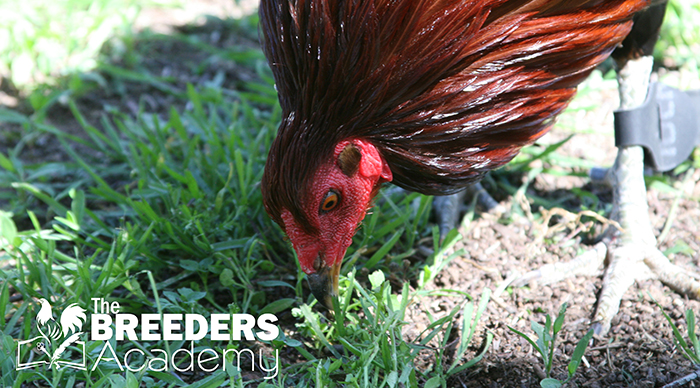
Culling cocks and stags:If you think about it, chickens and gamefowl are a heck of a lot like people. Some people have circulatory problems, such as heart and lung problems, vision problems, and knee problems, etc. Our fowl can also develop these types of problems, although, it is more prevalent in people because we abuse our bodies by smoking cigarettes, chewing tobacco, and consuming fats, salts, sugars, and alcohol, etc. We tend to take better care of our birds than we do ourselves.
With that in mind, if you’re a beginner looking to buy brood fowl, you’ll want to examined these fowl very closely. If it turns out that one of the birds has a problem with their lungs or some kind of circulatory problem, they will become winded very easily and their face may even begin to turn dark purple.
Watch the way they use their wings to fly. Is it graceful and elegant? Do they fly with ease or is it a chore?If they should fly to the top of a roost, watch the way they use their legs and feet to land, check to see if they land flatfooted.
Also, watch the way they walk. Is it with a quick and deliberate motion? They must show a confident demeanor. These are traits that you’ll need to watch for, anything showing problems such as these, disregard.
When selecting American Games – Look for birds that never seem to get sick and have the proper conformation of body, such as:
- Long straight toes, but pay special attention to the prop toe. This is where a cock gets his balance and helps to secure him during roosting. A good straight prop toe is what you’re looking for
- Low set spurs that are nearly touching the prop toe. The lower the spur on the leg, the better
- A medium/high station bird that stands with a slight bend or angle in his legs. A bird such as this is always ready for action and looks as if he were going to spring out like a cat
- He should have long thighs and short shanks, with long low set wings that amply protect the thighs and meet at the back of the vent
- He should also have a firm round, football type body that is “corky” to the feel. In other words, he should be firm, full bodied, but light in the hand
- I also like their tail to be large, full, and strong, and be carried at a good angle. This is very important, for this is the cock’s rudder
- Look for the bird with a good long neck that is heavy plumaged
- You want birds that have a deep-red or orange colored eye, make sure both eyes look exactly the same
- Make sure they have a head that is fine, neat, and small. Look for a head that shows they are alert, intelligent and clever. They must be active and alert at all times.
- And last but not least, make sure you like them! Don’t settle.
Remember, you cannot breed mediocre chickens. So be selective, and except nothing but the best.
Culling hens and pullets: Brood hens are very special, and you must learn how to cull properly in order to identify these special individuals. There is no need for anyone to keep anything but pullets that are a hundred percent perfect, especially with such a large field to select from. Culling is an ongoing process involving the removal of injured, sick, or defective birds whenever you spot them. As for pullets, the culling should be even more vigorous.
The culling process – for brood hens and laying hens:this is also known as a periodic procedure for determining whether or not a hen is laying, and if so, then determining how long she has been in or out of the lay. Culling time for hens is usually near the end of the first year of the breeding season. The first step in culling hens is to look at each hen’s:
- Overall Carriage. A good hen is always active and alert. A poor hen tends to be lazy and listless
- Next, look at details such as the Vent. A hen in the lay should have a large, moist and oval vent, not puckered and dry. Hens not in the lay will have tight, dry, round vents
- The Abdomen should feel soft, round and pliable under your hand, never small and hard
- The Pubic Bones, the pair of pointy bones located between the keel and vent should be wide apart and flexible, not tight and stiff. You should be able to fit at least two fingers between the pubic bones. A poor hen is tight and nonflexible in these two areas
- Her Eyes should be bright and sparkling, not dull and sunken in
- Comb and waddles should be bright, not pale
- Shanks should be round and smooth, not flat and rough
- The hens back should be broad, flat and heart shaped, not narrow or tapered.
The most reliable indicator is the pubic bones and vent.
What to look for:When it comes to conformation of body, especially in a breeding age pullet, let’s say around a year-old, some of the things that I look for, primarily in their physical appearance, is:
- A good round body with just a hint of a breast bone
- A long neck with a small, finely defined head
- Long straight toes, which includes the prop toe
- She should have good station consisting of long thighs with short shanks (which I consider to be a medium/high stationed bird)
- Long wide, low set wings that amply protect the thighs
- Her tail should be spread large, wide, and upright, (turkey tail as I’ve heard it called)
- And she should have a good heavy, but healthy plumage.
- I look for pullets that look like cheerleaders. In other words, they must look feminine, but with an athletic look about them.
When judging them, consider not only perfect body, but vigor, vitality and activeness, in other words, excellent health.
I can’t stress enough the importance of picking hens that are always busy and alert to their surroundings, meaning the first off,the roost in the morning and the last to go to roost in the evening. Those that scratch in the woods hunting for worms, bugs, grasshoppers, and are very aware of their surroundings for things such as hawks, or any other strange or threatening creatures. These are the kind of hens that are not only extremely healthy, but have great natural instincts, which can be passed onto their offspring.
Always select the most dominant pullets:Keep an eye on the dominant pullets. Not the outright mean ones. I can’t stand those that want to fight all other hens that cross their path. I’m sure you’ve notice that the best brood pullets were usually the ones that were always on the top of the “pecking order,” always cool and confident in their actions. Those are the ones you want to keep an eye on, the one or two who are dominant over all the others. As soon as you remove the dominant one, there will be another one to take her place. I agree in picking the dominant pullets as future brood hens, just not the mean ones, those are culled.
Locating that Golden Hen:The potential brood pullet is very important, as she will have more influence than her brothers in the anticipative improvement of the family. It was once thought that the cock and hen contributed equal share of their traits to their offspring. We now know that due to dominant and recessive traits, not to mention other genetic factors, that this is not true. Actually, it is the hen that is the deciding factor in the improvement of a family. In fact, she is the strain! Without that “Golden Hen” you have nothing.
It’s a never-endingquest to discover those golden hens, but they are out there. You just have to find them. If you happen to come across one of these hens, hold on to her tight. “Hide her under your bed,” as one of my mentors told me. Because there is always someone out there on the prowl, looking for those priceless hens, watching and waiting for the moment that they can beg, borrow, or steal her from you.
